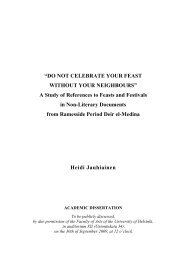BIA
bia51
bia51
Create successful ePaper yourself
Turn your PDF publications into a flip-book with our unique Google optimized e-Paper software.
FÉVRIER 2015<br />
A second Khent-kawes is also known. A<br />
block of limestone inscribed with words “the<br />
king’s wife Khent-kawes” has been found, and<br />
this, associated with the Fifth Dynasty pyramid<br />
of Neferirkare at Abûsîr, indicates that she may<br />
have been Neferirkare’s queen.<br />
In the 1970s, a Czech expedition under<br />
Miroslav VERNER found a small pyramid that<br />
belonged to her. Strangely, this Khent-kawes<br />
had the same titles as the Gîza one. Scholars<br />
postulate that the Abûsîr Khent-kawes was the<br />
mother of the pharaohs Raneferef and Niuserre.<br />
VERNER believed that the Khent-kawes of Abûsîr<br />
was different from the one attested to at Gîza<br />
and that she also ruled.<br />
functioned as ritual centres. We know that the<br />
king who came immediately after Raneferef was<br />
the son of Queen Khent-kawes II.<br />
From all this we can conclude that the<br />
name Khent-kawes was very popular among the<br />
royal family in the Fourth and Fifth Dynasties.<br />
The discoveries also emphasise the power of<br />
queens in ancient Egypt, because the evidence<br />
proves that Khent-kawes I actually ruled the<br />
country.<br />
The other major discovery made at Abûsîr<br />
was the Abûsîr papyri written in hieratic script<br />
and found inside the temple of Neferirkare. The<br />
papyri relate the functions of the temple and<br />
the role of the personnel within it.<br />
The limestone discovered<br />
Regarding the third Khent-kawes, whose<br />
tomb was recently found at Abûsîr, the<br />
expedition found some two dozen symbolic<br />
vessels made of limestone and four of copper.<br />
The most interesting find was in the burial<br />
chamber, where an inscription indicating that<br />
Queen Khent-kawes III was the wife of a king<br />
and also the mother of a king was found.<br />
Scholars theorise that this queen was the<br />
wife of King Raneferef, who was buried in an<br />
unfinished pyramid at Abûsîr, and VERNER was<br />
able to recover evidence attributing the<br />
pyramid to this king.<br />
Egyptologist Mark LEHNER believes that even<br />
though this pyramid is unfinished, it may be<br />
the only one in Egypt that can provide us with<br />
information regarding how Fifth Dynasty<br />
pyramids were constructed and how they<br />
The Arabic name Abûsîr is derived from the<br />
hieroglyphic word “pr-Wsir,” meaning the land<br />
or place of Osiris. The Greeks called the site<br />
Busiris. There are some 14 places named<br />
Abûsîr in Egypt. According to Egyptian<br />
mythology, each of these locations was thought<br />
to contain a piece of the body of the god<br />
Osiris, strewn all over Egypt by his murderer,<br />
the evil god Seth.<br />
The site still contains many secrets that can<br />
reveal much information about the history of<br />
the Fifth Dynasty. But the question arises of<br />
why the discovery was announced to the media<br />
twice. The first announcement was made by the<br />
Ministry of Antiquities, while the second was<br />
made by the American University in Cairo.<br />
Someone should explain. (Zâhî Hawwâs, “The<br />
tomb of Queen Khent-kawes III”, Al-Ahram<br />
Weekly, February 26, 2015).<br />
-<br />
- -<br />
-<br />
<strong>BIA</strong> LI — Janvier/Juin 2015 52



